Abstract
Respirable cotton dust, implicated in the pathogenesis of byssinosis, contains a number of bioactive compounds. These include lipopolysaccharide (LPS), tannins, bacterial peptides, byssinosin, iacinilene C, and 1,3-beta-D-glucan. The exact aetiological agent of byssinosis in such dust has not been definitively identified nor has its mechanism of action on lower lung surfaces been determined. In the present study 1,3-beta-D-glucan, Enterobacter agglomerans LPS, and ovine pulmonary surfactant were mixed in varying combinations. After incubation, their characteristics were determined by sucrose density centrifugation, TLC, and carbohydrate analysis. Precipitates were found in mixtures containing surfactant-glucan and surfactant-glucan-LPS, but not in surfactant-LPS. Precipitates were not seen in the surfactant, LPS, and glucan controls. The formation of a precipitate did not increase the density of the surfactant glucan mixture when compared by density gradient centrifugation with the surfactant control. The interaction between surfactant and glucan was analysed by molecular modelling. The energy of a surfactant-glucan complex (60.07 kcal/mol) was calculated to be much lower than the sum of glucan (47.09 kcal/mol) and surfactant (30.98 kcal/mol) when added separately. The results indicate that 1,3-beta-D-glucan does interact with surfactant and this complex may play a part in the pathogenesis of byssinosis by altering lung physiology maintained by pulmonary surfactant.
Full text
PDF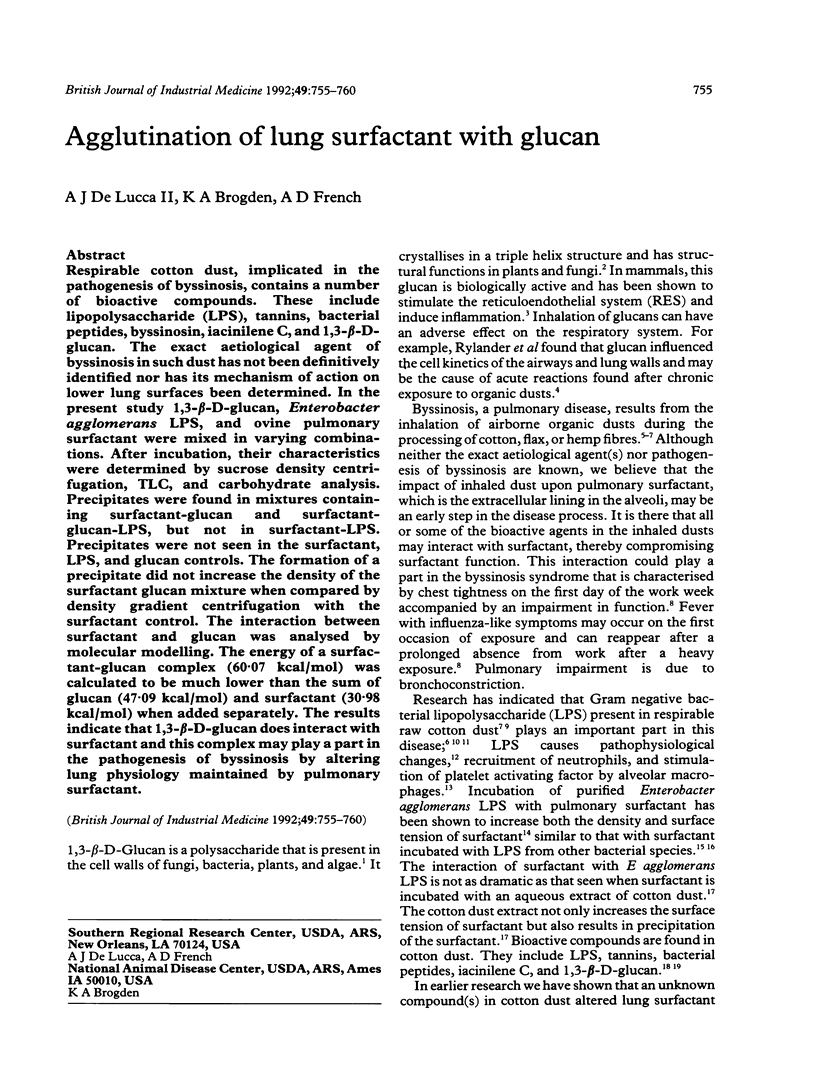
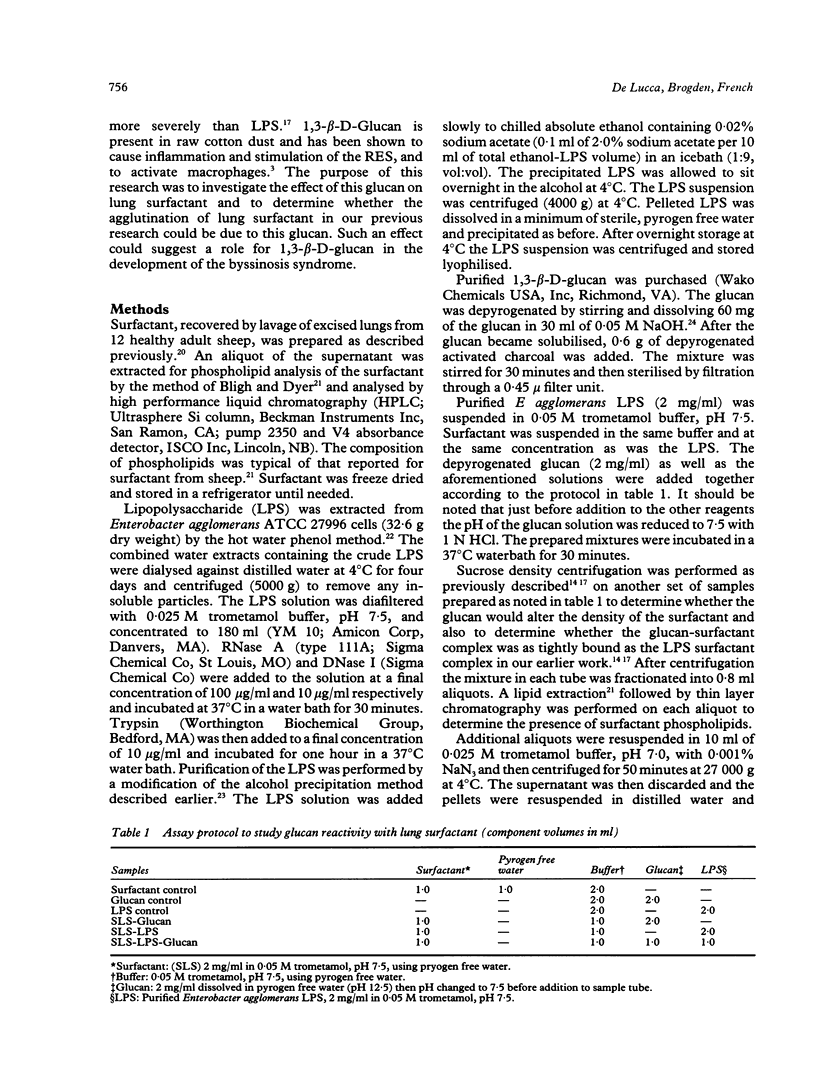
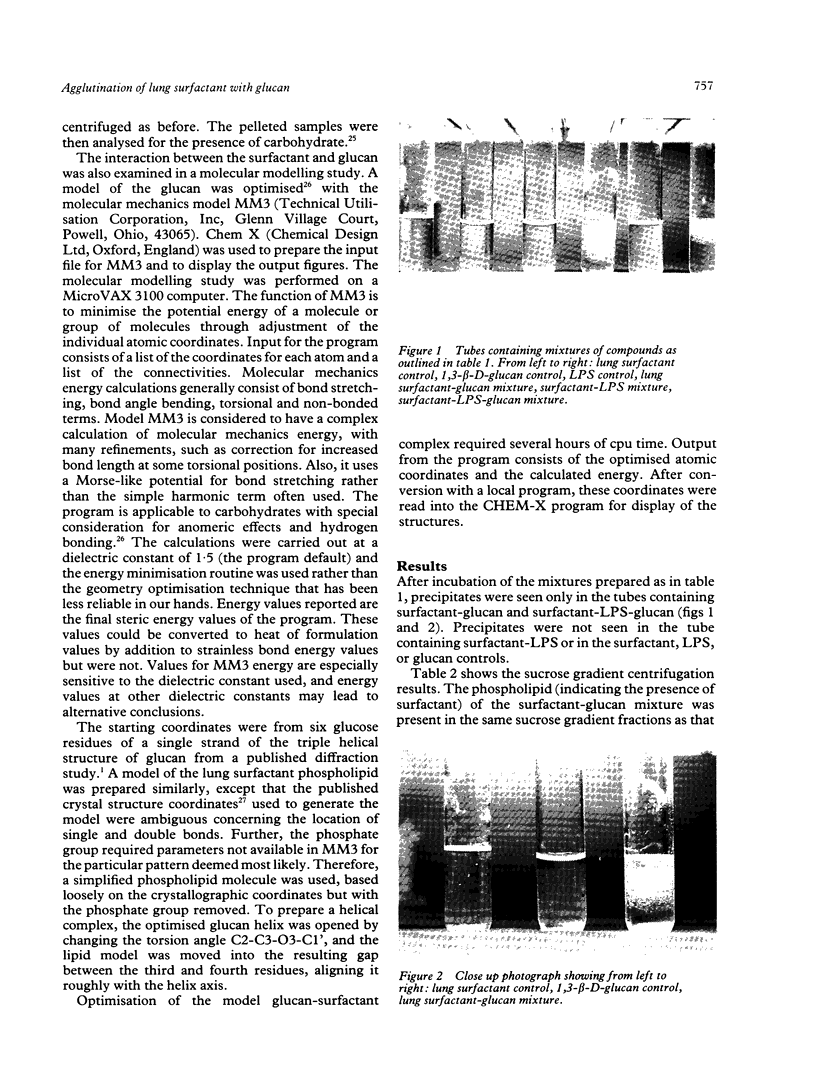
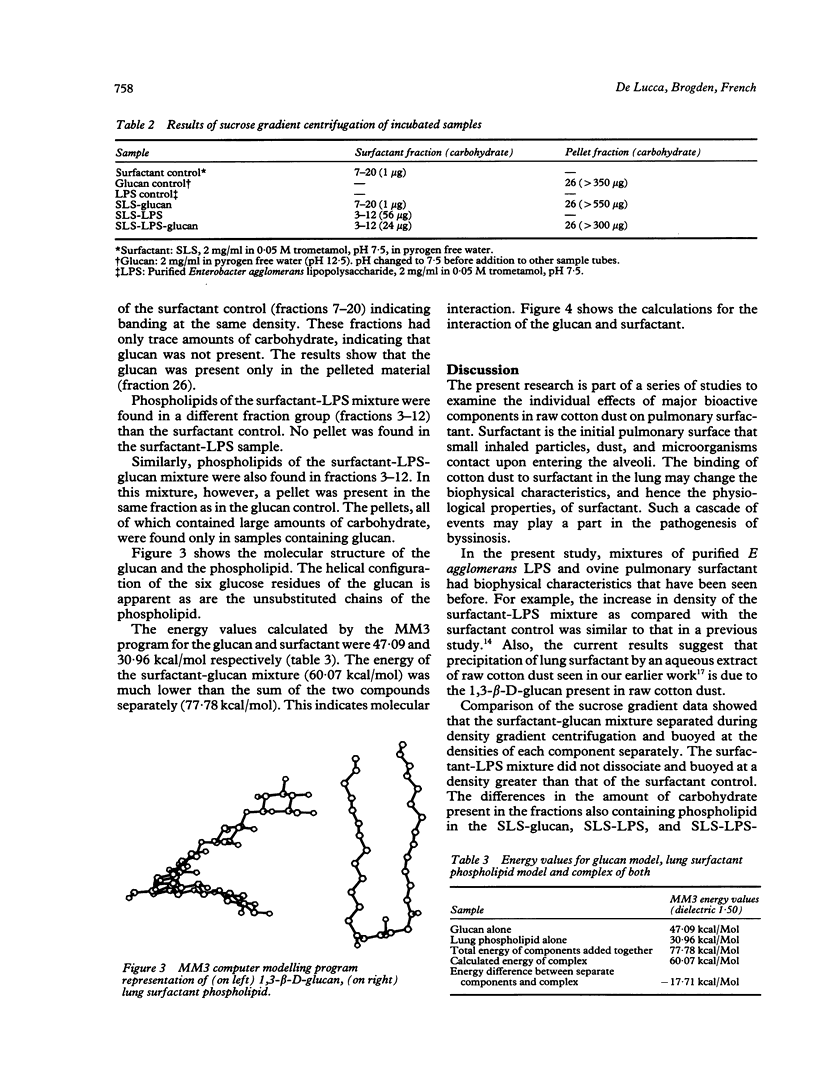
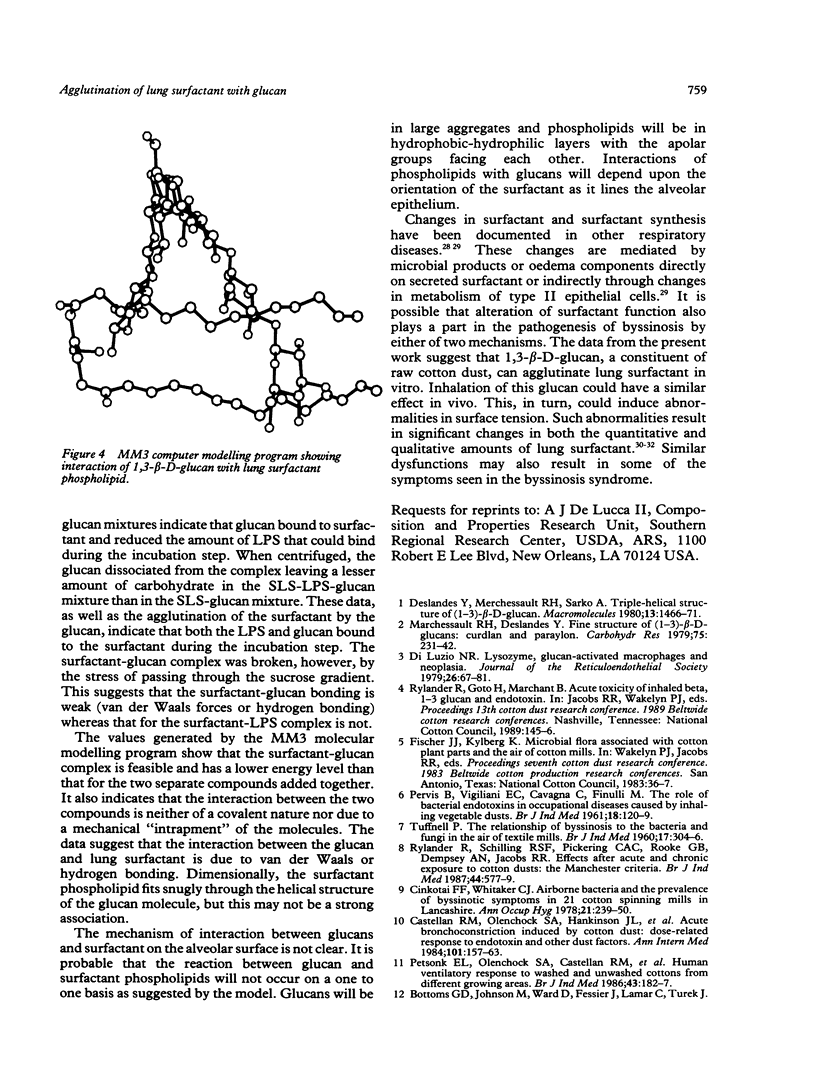
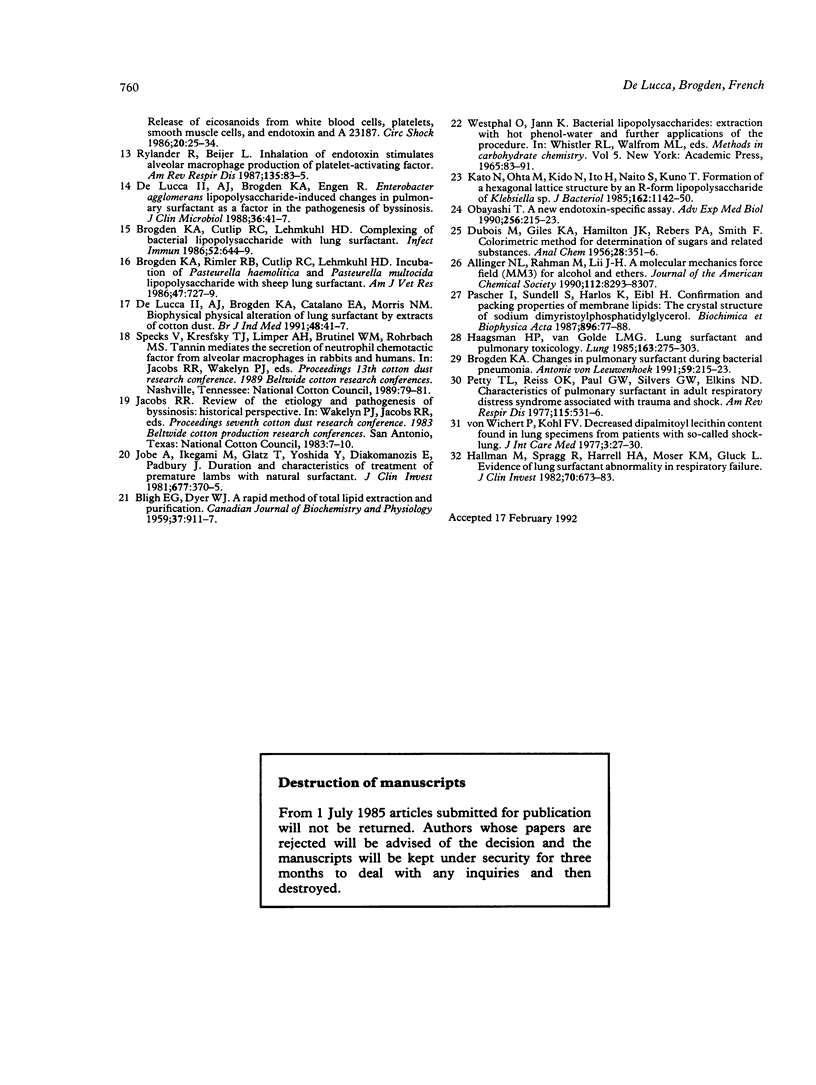
Images in this article
Selected References
These references are in PubMed. This may not be the complete list of references from this article.
- ATKINS E. L., PEARCE J. W. Mechanisms of the renal response to plasma volume expansion. Can J Biochem Physiol. 1959 Jan;37(1):91–102. [PubMed] [Google Scholar]
- Brogden K. A. Changes in pulmonary surfactant during bacterial pneumonia. Antonie Van Leeuwenhoek. 1991 May;59(4):215–223. doi: 10.1007/BF00583673. [DOI] [PubMed] [Google Scholar]
- Brogden K. A., Cutlip R. C., Lehmkuhl H. D. Complexing of bacterial lipopolysaccharide with lung surfactant. Infect Immun. 1986 Jun;52(3):644–649. doi: 10.1128/iai.52.3.644-649.1986. [DOI] [PMC free article] [PubMed] [Google Scholar]
- Brogden K. A., Rimler R. B., Cutlip R. C., Lehmkuhl H. D. Incubation of Pasteurella haemolytica and Pasteurella multocida lipopolysaccharide with sheep lung surfactant. Am J Vet Res. 1986 Apr;47(4):727–729. [PubMed] [Google Scholar]
- Castellan R. M., Olenchock S. A., Hankinson J. L., Millner P. D., Cocke J. B., Bragg C. K., Perkins H. H., Jr, Jacobs R. R. Acute bronchoconstriction induced by cotton dust: dose-related responses to endotoxin and other dust factors. Ann Intern Med. 1984 Aug;101(2):157–163. doi: 10.7326/0003-4819-101-2-157. [DOI] [PubMed] [Google Scholar]
- Cinkotai F. F., Whitaker C. J. Airborne bacteria and the prevalence of byssinotic symptoms in 21 cotton spinning mills in Lancashire. Ann Occup Hyg. 1978 Dec;21(3):239–250. doi: 10.1093/annhyg/21.3.239. [DOI] [PubMed] [Google Scholar]
- DeLucca A. J., 2nd, Brogden K. A., Catalano E. A., Morris N. M. Biophysical alteration of lung surfactant by extracts of cotton dust. Br J Ind Med. 1991 Jan;48(1):41–47. doi: 10.1136/oem.48.1.41. [DOI] [PMC free article] [PubMed] [Google Scholar]
- Di Luzio N. R. Lysozyme, glucan-activated macrophages and neoplasia. J Reticuloendothel Soc. 1979 Jul;26(1):67–81. [PubMed] [Google Scholar]
- Haagsman H. P., van Golde L. M. Lung surfactant and pulmonary toxicology. Lung. 1985;163(5):275–303. doi: 10.1007/BF02713827. [DOI] [PubMed] [Google Scholar]
- Hallman M., Spragg R., Harrell J. H., Moser K. M., Gluck L. Evidence of lung surfactant abnormality in respiratory failure. Study of bronchoalveolar lavage phospholipids, surface activity, phospholipase activity, and plasma myoinositol. J Clin Invest. 1982 Sep;70(3):673–683. doi: 10.1172/JCI110662. [DOI] [PMC free article] [PubMed] [Google Scholar]
- Jobe A., Ikegami M., Glatz T., Yoshida Y., Diakomanolis E., Padbury J. Duration and characteristics of treatment of premature lambs with natural surfactant. J Clin Invest. 1981 Feb;67(2):370–375. doi: 10.1172/JCI110044. [DOI] [PMC free article] [PubMed] [Google Scholar]
- Kato N., Ohta M., Kido N., Ito H., Naito S., Kuno T. Formation of a hexagonal lattice structure by an R-form lipopolysaccharide of Klebsiella sp. J Bacteriol. 1985 Jun;162(3):1142–1150. doi: 10.1128/jb.162.3.1142-1150.1985. [DOI] [PMC free article] [PubMed] [Google Scholar]
- Obayashi T. A new endotoxin-specific assay. Adv Exp Med Biol. 1990;256:215–223. doi: 10.1007/978-1-4757-5140-6_19. [DOI] [PubMed] [Google Scholar]
- PERNIS B., VIGLIANI E. C., CAVAGNA C., FINULLI M. The role of bacterial endotoxins in occupational diseases caused by inhaling vegetable dusts. Br J Ind Med. 1961 Apr;18:120–129. doi: 10.1136/oem.18.2.120. [DOI] [PMC free article] [PubMed] [Google Scholar]
- Pascher I., Sundell S., Harlos K., Eibl H. Conformation and packing properties of membrane lipids: the crystal structure of sodium dimyristoylphosphatidylglycerol. Biochim Biophys Acta. 1987 Jan 9;896(1):77–88. doi: 10.1016/0005-2736(87)90358-0. [DOI] [PubMed] [Google Scholar]
- Petsonk E. L., Olenchock S. A., Castellan R. M., Banks D. E., Mull J. C., Hankinson J. L., Bragg K. C., Perkins H. H., Cocke J. B. Human ventilatory response to washed and unwashed cottons from different growing areas. Br J Ind Med. 1986 Mar;43(3):182–187. doi: 10.1136/oem.43.3.182. [DOI] [PMC free article] [PubMed] [Google Scholar]
- Petty T. L., Reiss O. K., Paul G. W., Silvers G. W., Elkins N. D. Characteristics of pulmonary surfactant in adult respiratory distress syndrome associated with trauma and shock. Am Rev Respir Dis. 1977 Mar;115(3):531–536. doi: 10.1164/arrd.1977.115.3.531. [DOI] [PubMed] [Google Scholar]
- Rylander R., Beijer L. Inhalation of endotoxin stimulates alveolar macrophage production of platelet-activating factor. Am Rev Respir Dis. 1987 Jan;135(1):83–86. doi: 10.1164/arrd.1987.135.1.83. [DOI] [PubMed] [Google Scholar]
- Rylander R., Schilling R. S., Pickering C. A., Rooke G. B., Dempsey A. N., Jacobs R. R. Effects after acute and chronic exposure to cotton dust: the Manchester criteria. Br J Ind Med. 1987 Sep;44(9):577–579. doi: 10.1136/oem.44.9.577. [DOI] [PMC free article] [PubMed] [Google Scholar]
- TUFFNELL P. The relationship of byssinosis to the bacteria and fungi in the air of textile mills. Br J Ind Med. 1960 Oct;17:304–306. doi: 10.1136/oem.17.4.304. [DOI] [PMC free article] [PubMed] [Google Scholar]
- Wichert P., Kohl F. V. Decreased dipalmitoyllecithin content found in lung specimens from patients with so-called shock-lung. Intensive Care Med. 1977 Apr;3(1):27–30. doi: 10.1007/BF01683185. [DOI] [PubMed] [Google Scholar]




